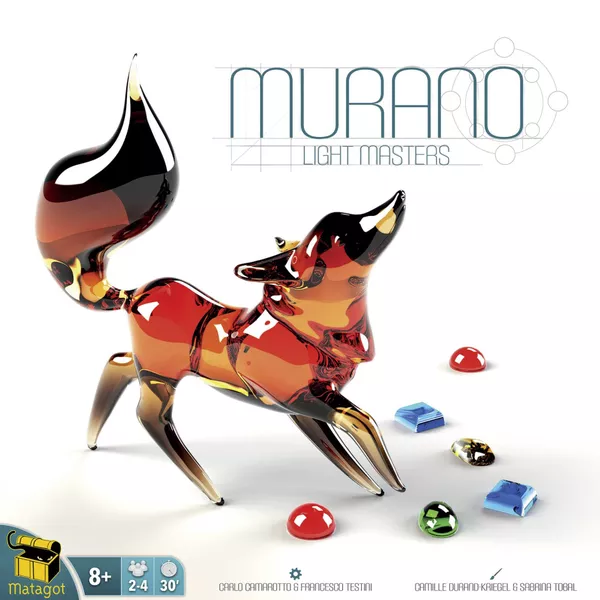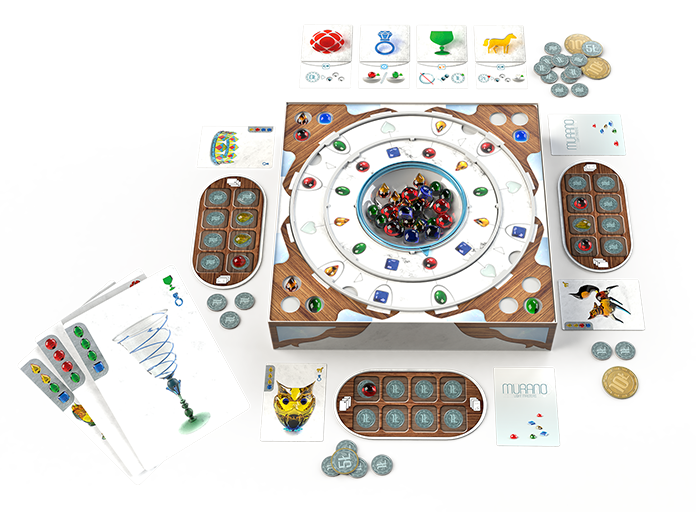Manipulate Glass, Fulfill Orders, and Maximize Your Commissions in Murano: Light Masters

Collect shards of glass to create beautiful works of art. Keep your work bench clean, and make each move count, in order to become the wealthiest glass maker in Murano.
Published by Matagot, Murano: Light Masters is an abstract strategy game for 2-4 players that is played in roughly 30 minutes. There are now a number of games about creating beautiful works of art with abstract gameplay, so how does this one play?
Gameplay
The board is made up of a central bowl that holds the supply. You place the glass shards in there. These come in five different colors: red, blue, yellow, green, and white (white acts as a wild color). Around the supply are two rings, depicting the colored shards. The outside ring can be rotated. Around the supply bowl, there is a selector which can be rotated to point at shards on the rings. During the game setup, you randomly line this and the rings up so that it points towards any two shards on the two rings. Finally, at the four corners of the board are the marketplaces. Each marketplace has room for three shards, and each marketplace is connected to three shards depicted on the outer ring.
On your turn, you must go through three phases. During the first phase, you rotate the selector one space clockwise, so that it is pointing at two new shards. You then take those shards from the supply. Whenever you gain shards in the game, you place them on your workbench. You have space for eight shards on your workbench. If you would ever have more than eight shards, you must choose which ones to return to the supply.
During phase two, you choose to exchange, buy, or sell. If you exchange, you take one shard from your workbench and place it at any marketplace where there is an empty space. You then take one of each shard that is shown on the ring which is connected to that marketplace, except for white shards (which cannot be gained in this way). If you buy, you spend two coins to gain all the shards currently placed at one of the four marketplaces. If you sell, you must return at least one shard from your workbench to the supply (but may return as many as you wish) and gain a single coin.
Finally, you move on to the last phase of your turn. During this phase, you may complete the creation cards in your hand. At the start of the game, you are dealt five of these (six in a two-player game). Only you may see them, and while you may look through all the cards, they must remain in a stack in your hands, and you may only complete the card that is currently on top of the stack. Each creation card requires four shards of specific colors to complete. When you complete a creation card, you place it face-up in front of you and return the required shards to the supply. You then earn one coin for each empty space on your workbench. It is possible to complete two creation cards on your turn. If you manage this then you earn two coins as a bonus.
At any time on your turn, you may also take the following three actions, as many times as you wish and are able: you may spend one coin to rotate the outer ring counter-clockwise one notch; you may spend one coin to move the top card on your creation card stack to any other position in the stack; and you can activate advantages.
There are four creation categories. Each creation card will belong to at least one of these categories. There are also four tiles, one to represent each category. At the start of the game, you shuffle the advantage cards and deal one to each of these category tiles. These are special abilities, such as allowing you to take one color of shard from the supply or allowing you to use the buy action for free. On your turn, you may flip over one of your completed creation cards in order to use the ability associated with that card’s category.
The game ends once one player has completed all five of his creation cards and everyone has had an equal number of turns. The player with the most coins then wins the game.

Review
Murano: Light Masters poses an interesting strategic choice. Do you collect as many gems as possible, as quickly as possible, to try to set yourself up to complete your creation cards as fast as you can? Or do you hold back, taking actions that will collect fewer gems, which will make the creation cards you complete worth more coins? On top of this, each creation card you complete gives you a chance to use a special ability, so you have to weave the options those give you into your choices as well.
This is a game about setting up great moves and trying to manipulate the board to get the most out of each choice. Spending coins to rotate the ring or reorganize your creation card stack can be extremely helpful, but you need to be careful how often you do it since those coins are what win the game.
Turns are quite fast, and there will be minimal downtime even with four players. There isn’t a great deal of direct player interaction, though. You don’t see each other’s creation card stacks, so you don’t even really have enough information to block an opponent. But their actions can often thwart your plans by chance, so you do have to adapt based on what they choose to do.
Aesthetically, the game is sleek, elegant, and attractive. It does its theme justice, from the artwork on the creation cards to the shards. The rings work well, but we did find the selector easy to knock off its track when reaching into the supply and the iconography on the ability cards is often unclear. We often had to refer to the rulebook to remember what they did.
With a pleasant, pretty theme that is nicely backed up by aesthetics, Murano: Light Masters is a simple game to learn, with an interesting scoring system. For fans of abstract games, who enjoy trying to get the most out of each turn, this should be a hit.
Pros: Fast turns, beautiful aesthetics and theme, great scoring system
Cons: Selector component kept coming off its track, iconography on ability cards is confusing, minimal direct player interaction







